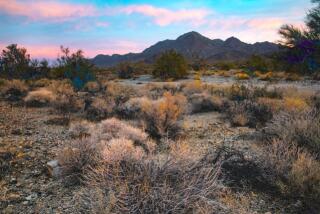Fate of Possible Chumash Artifacts to Be Discussed
- Share via
Native Americans, archeologists and Ventura County officials will meet today to determine what to do with a new find of possible Chumash artifacts discovered recently at the site of a road improvement project near Camarillo.
The find, a series of smooth, rounded stones in a semi-circular pattern, marks the second major discovery at the site on Santa Rosa Road since a human tooth and bone fragments were unearthed Dec. 22.
The stones were found about two weeks ago during construction of a trench to be used by archeologists and officials from Native American groups to further study the sacred and historical significance of the location.
“We have to meet to formulate a plan as to what to do with this site,” said Larry Myer, executive secretary of the California Native American Heritage Commission. “From what we have been told, this could very well be a very important find.”
W. Butch Britt, the county’s deputy director of public works, said county-paid archeologists are digging a 200-foot-long trench at the site to allow officials a chance to examine the area more fully. Work on the two- to three-foot-deep trench is about three-quarters complete, he said.
“We are attempting to be as thorough with this as we can be,” Britt said. “But the problem is that we are more than two months behind in this project and that it has cost us more than $20,000 to find out what’s there. That figure is growing each day.”
Road improvements are continuing at another location and the archeological dig has not resulted in any construction delays, Britt said.
The tooth and human bone fragments found at the site may have been among remains in a burial urn, officials said.
The pieces have been carefully reburied in Chumash tribal custom under the direction of an Ojai woman deemed by the commission as the most likely to be a descendant of the deceased person, Myer said. The commission made that determination based on interviews, a genealogy search and the location of the burial site, commission officials said.
The name of the woman and the location of the new burial site were not disclosed.
According to one archeologist who studied the Santa Rosa Road site in December and January, evidence appears to be mounting that it is a former Chumash burial ground and may be the site of a long-lost Chumash village.
“It’s a graveyard and we have tried to tell that to the county,” said Renee C. Fraser, a Simi Valley-based archeologist. “Present work on the site indicates that there may be the remains of as many as eight people there, probably more. This is something that the county clearly doesn’t want to hear about.”
Fraser said the discovery of the stones and their placement in the ground indicates the location may have been a cremation site.
“I haven’t seen the new find, but it sounds from the description of the stones that they found another cremation chamber,” Fraser said. “I’d have to see it to be sure, though.”
Britt, however, said the county remains willing to continue working with the commission and other state and local Native American groups to resolve the situation.
“We want to do what’s right,” Britt said. “But we also want to fix a road that a lot of people use that isn’t really safe. We have a responsibility to the people who use that road.”
More than 10,000 motorists a day use the hilly, two-lane road, according to county estimates. The construction work, being completed in three phases, is designed to smooth out many of the road’s blind hills and curves and to widen its lanes.
Work on the 11-mile-long road started in 1990 and is scheduled to be completed sometime next year at a cost of about $5 million.
More to Read
Sign up for Essential California
The most important California stories and recommendations in your inbox every morning.
You may occasionally receive promotional content from the Los Angeles Times.













